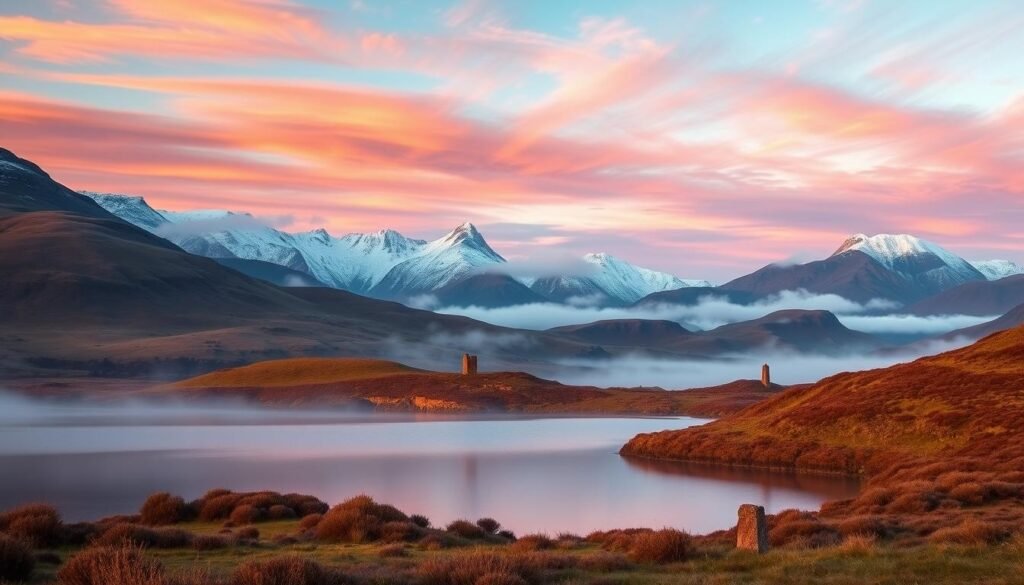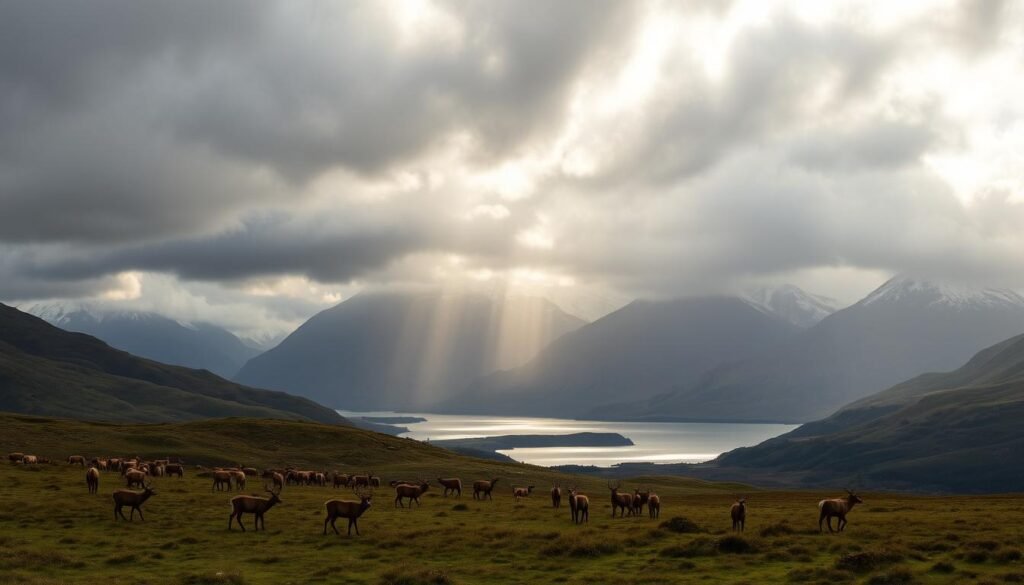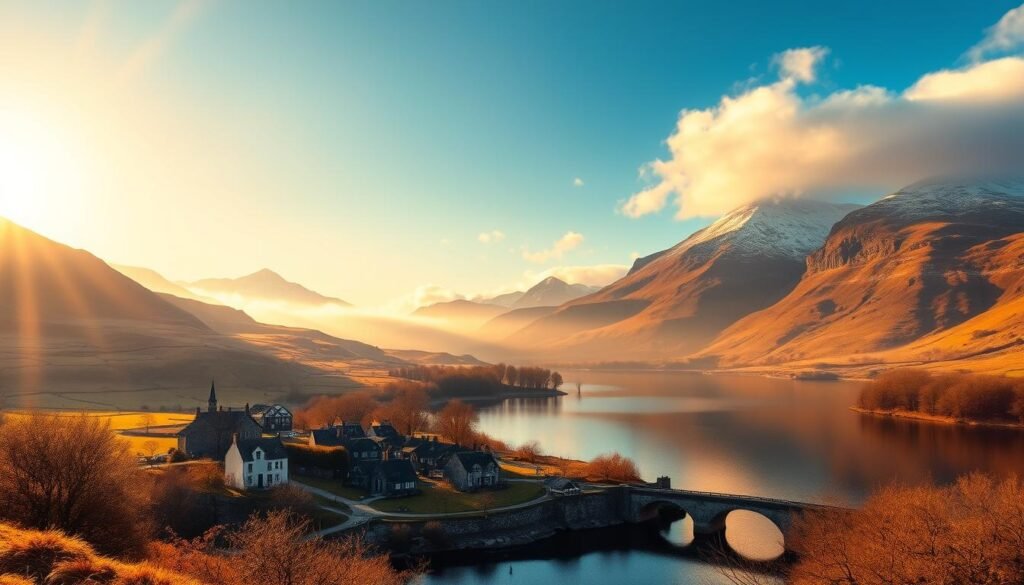Surprising fact: I once found the streets of Skye nearly empty in April, yet the coastline teemed with nesting puffins — fewer crowds with big rewards.
I write from years of travel and quick trips across this country. I usually aim for shoulder seasons in April–May or September–October.
Those windows balanced comfort, cost, and easy movement. March–May often brings the driest stretch and temps around 40–55°F. Summer warms up but rarely gets hot in cities like Edinburgh.
I set expectations about changeable weather and packing. Short winter days arrive fast, with sunsets near 4 p.m., though southern cities avoid extreme cold.
My shortlist of places includes Edinburgh, Glasgow, Loch Ness, Ben Nevis, Glen Coe, and the Isle of Skye. Off-season trips give more room to roam, while winter adds markets, Hogmanay, and skiing at CairnGorm and Nevis Range.
Key Takeaways
- Shoulder seasons (April–May, Sept–Oct) offer fewer crowds and pleasant conditions.
- March–May is usually the driest stretch with mild temperatures.
- Summer is warmer but seldom hot in major cities.
- Winter brings short days, festivals, and mountain skiing options.
- Major highlights: Edinburgh, Glasgow, Skye, Glen Coe, Lochs, and peaks.
- Plan clothing for changeable weather and flexible daily plans.
My quick answer and how I decide when to go
I narrow my travel windows with a simple rule: choose shoulder months that give long days, fair weather, and fewer crowds. For me that usually means planning a trip in April–May or September–October.
My past-experience snapshot: why I favor spring and fall
Spring (March–May) tends to be the driest stretch and often sits around 40–55°F, so outdoor plans stick without constant rewrites. Fall brings similar temps and great foliage that makes drives and hikes feel special.
How I weigh weather, daylight, crowds, events, and budget
I put weather first, then check how many days of daylight I’ll get—longer days let me fit more into one trip. Crowds and accommodation prices push me away from August in cities like Edinburgh.
- Crowds & costs: Peak summer spikes prices; festival weeks fill hotels fast.
- Events: I slot my trip around whisky festivals or Highland Games when they match my interests.
- Midges: These insects peak July–August, so I prefer late September–early May for Highlands hikes.
- Budget: Late fall and winter can offer deals, but avoid holiday weeks for savings.
My way is to pick one anchor month, pencil in must-do experiences, and leave room for a weather pivot. If you want a concise planning primer, see this best time visit guide.
best time to visit scotland: months, crowds, prices, and daylight at a glance

I track the months, crowds, and daylight like a simple checklist before I book any trip. That helps me pick windows that balance weather, value, and freedom to explore.You can learn more about best-places-to-visit
Quick overview: April–May and September–October are my go-to shoulder months for longer days, fair weather, and fewer crowds. June–August is the high season; expect higher prices and the tightest bookings, with July August the peak for festivals and heavy traffic.
- Weather & days: March–May is usually the driest stretch; summer brings the warmest temps and very long daylight in the north.
- Booking pressure: Crowds and costs spike in summer—plan ahead if you travel then.
- Midges: Midges thrive May–September and peak in July August; late September through early May lowers the risk.
I often aim for shoulder months because the months blend workable weather with better value. For scheduling tips and extra detail, see this when to go guide.
Season-by-season guide to visiting Scotland
I plan trips around what each season offers—quiet wildlife watches in spring, roaring festivals in summer, and cozy winter stays.
Winter (November–March)
Winter brings short days, roaring fires, and major events like Hogmanay and Burns Night.
I seek cozy lodges and ski days at CairnGorm, Glencoe, or Nevis Range. Snow often turns the Highlands into a postcard.
Spring (March–May)
Spring feels crisp and dry; trails firm up and wildlife activity spikes.
I chase puffins, ospreys, and seals, and time distillery visits for whisky festivals in late April.
Summer (June–August)
Summer has the longest days and packed festivals—from the Fringe to Highland Games.
I book events early and use dawn starts in busy cities to beat crowds.
Fall (September–October)
Fall delivers golden landscapes and the deer rut; weather is steadier and value often improves.
Where to go & weather watch
“Balance city museums with wild landscapes each season and keep a weather backup plan.”
- Edinburgh and Glasgow suit cold or wet days indoors.
- Isle of Skye and the Highlands shine in spring or late fall, but watch for snow and gales.
My rule: mix cities and landscapes so travel plans survive changing weather and short days across the year.
Plan your trip by interests: cities, landscapes, wildlife, and events

I match each trip to a central interest—arts, wild places, or festivals—then build the days around that anchor.
City culture and festivals
I book around major events when I want nonstop culture. Edinburgh’s August Fringe and Art Festival fill streets and raise prices.
Hogmanay draws huge crowds—over 40,000 in the city—so I lock accommodation and timed entries well ahead.You can learn more about best-european-countries-to-visit/
Highlands and islands road trips
For landscapes and wildlife, I favor early spring on Skye for puffins and shoulder-season weeks for quieter roads.
Late September gives crisp light and fall color in Perthshire, which makes driving memorable without tour-bus congestion.
Budget strategies and practical tips
I save by targeting low-season months outside the holiday spike and mixing a splurge night with midrange stays.
To keep the trip scotland cadence smooth, I pre-book ferries, a few restaurants, and must-see attractions by season.You can learn more about best-time-to-visit-morocco
| Interest | Good months | Quick tip |
|---|---|---|
| City culture & festivals | August, December (Hogmanay) | Book accommodation near venues early |
| Landscapes & road trips | April–May, Sept | Choose shoulder-season weeks for less traffic |
| Wildlife | Early spring, late summer for seals | Use dawn trips and respectful distances |
My rule: pick one anchor interest, then plan flexible days around weather and local events.
Conclusion
I still find the right month changes how a trip feels. Spring and fall give the best balance of weather, wildlife, and lower crowds.
Summer brings long days and festival energy, though higher demand and busy streets are common. Winter offers festival highs like New Year and ski days, but expect short days and possible snow in the Highlands.
My simple planning tip: pick a month that fits your calendar, add one city stay and a Highland or island leg, and book key events early. Avoid July–August if midges matter, and leave a day or two for flexible weather plans.
Choose the right window and Scotland will reward you in every season.





















